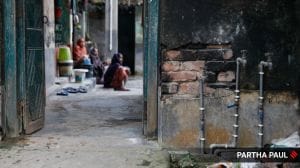Stay updated with the latest - Click here to follow us on Instagram
Assam Albums
Vivek Singh's photographs of last year's violence in Assam have been selected for the famous Les Rencontres dArles exhibition in Paris
In July 2012,when news of communal violence in Assam pounded our television screens,Gurgaon-based photographer Vivek Singh looked at the images with no renewed interest. Ive been covering ethnic conflict,displacement and social issues in Assam since 2006 and instances of violence have been common for over two decades now. Yet,the Northeast is hardly in the news, says the 32-year-old. He sounds immune,like a person bleached of anger.
Singh eventually packed his bags and,with all modes of transport blocked (trains were cancelled and taxi owners demanded exorbitant deposits before they rented out their vehicles),he set out for Assam. He took a local train to the New Bongaigaon district of Assam,and local friends helped him navigate his way.
On his route lay one burned-down village after another,with an occasional CRPF personnel telling him,Yahan kuchh nahi hai (Theres nothing here). He saw razed structures,remnants of what probably had been a place of worship or someones concrete house,standing out like fresh wounds in the still,tropical weather. The atmosphere was very tense and there was an uneasy calm, says Singh.
Covering the Bodoland Territorial Autonomous District areas of Kokrajhar,Dhubri and Chirang,Singh took on the battered lands with his camera for a month and followed it up with another stint in January this year,at the several relief camps dotting the districts.
As his photographs of these visits,spread across 15 matt prints in black and white,go up on display at Les Rencontres dArles a prominent international photography festival in Arles,Paris Singh says,almost in frustration,Whats crazy is that people dont know that theres a place called Kokrajhar. That was exactly the reason for the photographs taken.
At the Les Rencontres dArles,Singh beat 12 photographers from across the world to win The Manuel Rivera-Ortiz Foundation for Documentary Photography & Film grant,selected by a prestigious jury that includes Lucien Clergue,founder of Les Rencontres dArles; and Christian Caujolle,founder of Agency and Gallery VU in France and Founder and Arts Director of Photo Phnom Penh festival,among others.
Singhs series,titled Ethnic Unrest,Western Assam The Aftermath,sketches a disturbing yet poignant state of Assam after it witnessed ethnic violence between the Bodos (considered the original inhabitants of the area) and migrant Bengali Muslim populations in July 2012.
Singh,a native of Rohtak,Haryana,started with journalistic aspirations. But he was clear about one thing: That I wouldnt sit in an office. After honing his skills in photography between 2000 and 2004,Singh was awarded a fellowship by National Foundation for India in 2006,sending him to the Northeast. Forget about national coverage,the Northeast doesnt even get local attention. I would equate this episode to the Uttarakhand tragedy,yet theres no one to cover it, says Singh,who started photographing the Northeast because of its low coverage.
In Assam,his photographs involve several portraits,mostly of women and children,of their immune,weather-beaten faces,along with the war-torn landscapes. Once I started to shoot,I was direct and didnt play any tricks. These photographs are simple and straight, says Singh.
Several stories came along his way from a respected professor who was killed right outside his house,sparking violence in the area,to a burned-down place of worship about 15 miles from Kokrajhar,the site of a fierce overnight battle where even the police force was said to hesitate to intervene.
The photographs will be displayed in Paris till the end of this month,but a show in India is in the works.







